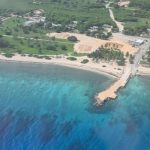Battle against coral disease makes slow progress
(CNS): For over 18 months the Department of Environment has been battling the devastating impact of stony coral tissue loss disease (SCTLD) on local reefs and that persistent work is beginning to have an effect, officials have revealed. Direct application of antibiotic ointments to living corals that are not infected, repeated daily by the response dive team, is showing some headway.
But DoE experts say it’s not a quick fix and they’re still waiting for the scientific community to find more solutions to this latest threat to our reefs.
Appearing on Radio Cayman’s For the Record last Friday, SCTLD Response Team researchers Sabrina Weber and Tammi Warrender explained how challenging it is to tackle the disease, which is now impacting the reefs all around Grand Cayman.
Scientists are still not sure exactly what this disease is, how it originated or how it spread through the region. However, the latest research suggests it is infecting the tiny plants that live inside corals that supply them with most of the nutrients they need and are responsible for the corals’ colour. After the plant dies, from what is probably a virus, the coral also dies.
Warrender said that a great deal of work is going on to learn more about the disease so that they can respond to it and try to prevent more corals from dying. So far, the only thing that has been shown to work is the application of a sticky ointment directly onto the corals, which is done by divers.
“We have a number of SCTLD response divers and we go out every day applying antibiotic ointments to the corals,” said Weber. “It’s like a very sticky paste that we bring underwater and we put it along the line of infection. We can’t bring back what is lost but we are trying to protect the healthy tissue on the corals that remain. The disease can kill corals within a number of weeks to months and we are going to priority sites.”
She explained that the divers, including volunteers, are repeatedly doing this work. There is hope that, as the science advances, they can do more to try to preserve the coral before it’s infected, but right all they can do is apply the ointment and persuade people using the water to thoroughly clean their boats and kit to curb the spread.
Over 20 countries in the Caribbean have discovered the problem in their waters and more than half are also responding with the paste. Warrender explained there was also a lot of collaboration with the US, where much of the research is being conducted.
It is believed that the researchers and volunteers of the Cayman Islands have been able to treat more coral than anywhere else and could be the most successful country so far to treat SCTLD, she said.
Because Cayman’s reefs are close and accessible, the response team can intervene and treat more corals than most other destinations and repeat the treatment, Warrender said, noting that divers are seeing some success from their work.
Nevertheless, SCTLD is affecting more than twenty different coral species and there are concerns that, even with Cayman’s concerted efforts to address this disease, it will irrevocably change the local reefs and reduce the diversity of coral.
See Warrender and Weber on Radio Cayman’s YouTube channel below and for more information visit the DoE website.
- Fascinated
- Happy
- Sad
- Angry
- Bored
- Afraid
Category: Local News






































Waste of time and money.
Is this a real article? Divers are applying antiseptic ointment to corals on a daily basis? Considering the miles of reef this must be quite an undertaking.
its very real and affecting the reefs throughout the region. We are doing our best to protect what we have, and if it take diving daily to apply, we’ll do it. Reefs are vital for food, tourism, coastal protection and are living structures. You ought to try educating yourself on the world around you.
It’s all that steel and cement and the over flow of waste seeping from out of the coastline,but hey I guess it’s for progress and very beneficial to our society.
Another opportunity for the private sector to try and rip off Government.
Nonesense.. True resaon coral looks little bitter is because there are no Cruise ships to damage and pollute..
No what the article is talking about. the disease makes the coral look worse, the treatment just makes those diseased corals not as diseased. No one is saying the reefs are looking better.
Climate change due to people burning of fossil fuels is to blame.